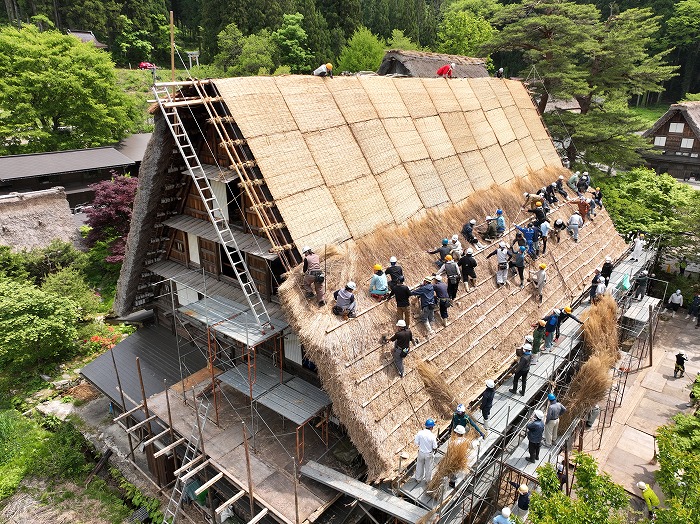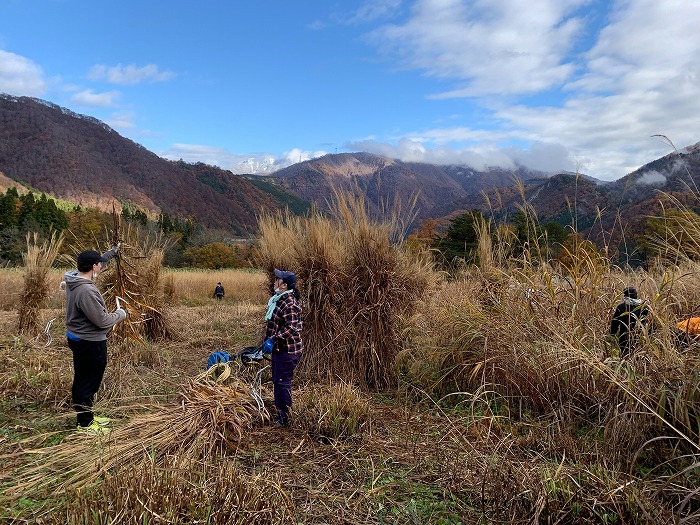最終更新日:2023年12月15日

Thatching Roofs and "Yui"
The thatched roofs of gassho-style houses get worn down by the elements and must be replaced at regular intervals, usually once every 20 to 30 years. In Shirakawa-go, thatching has traditionally been a cooperative effort that can involve up to 200 villagers at a time. The spirit of such cooperation, in which strict reciprocity is assumed, is referred to as yui. The owner of a house first calls upon his immediate neighbors, who are part of the same residents’ group (kumi). If the house is small, the thatching can be accomplished by a single kumi, while help from other parts of the village is required for larger buildings.
Before the age of plastic sheets, a roof had to be thatched in a single day, and most re-thatching projects still follow this schedule. The family of the house gathers before dawn to remove the old thatch and prepare the roof for the arrival of the yui participants, who are accorded different roles depending on their skills and experience. The most senior usually supervises the work, while young villagers are tasked with handing bundles of grass to the thatchers on the roof or cleaning up after them. Members of the house owner’s family serve refreshments during the day, and together with other villagers prepare a feast called naorai for all participants to partake of once the roof has been thatched.
The contributions of each yui participant, from work performed and thatching materials arranged to the number of sake bottles provided for the feast, are recorded in a booklet called a yui-cho. Such record-keeping helps ensure fairness and reciprocity, which are two of the key values of the yui tradition. The oldest yui-cho still in existence is from 1792, proving that the thatching of roofs has been a cooperative undertaking in Shirakawa-go for more than two centuries. Though re-roofing is nowadays usually carried out by professionals, villagers still get together at least once a year, usually in spring or autumn, to thatch a roof in the spirit of yui. This is done to make sure that the techniques involved are passed on to the next generation.

Thatching Materials
The type of grass used to thatch the roofs of gassho-style houses in most of Shirakawa-go was traditionally a variety of miscanthus called kariyasu. The grass was grown on the hillsides of the Sho river valley, usually at high altitudes where sunlight was abundant and the soil suitable. Each family had its own field, which was tended to during the summer and harvested from late October to the end of November, before the snowy season. The harvest had to be completed before the first snowfall and was very labor-intensive: An experienced worker could reap 60 to 100 bundles of grass in a day, whereas some 10,000 bundles were needed to thatch an average roof. The harvested grass was initially dried and stored on the hillside in large cylindrical stacks called nyu. When a roof needed to be thatched, the nyu was disassembled. The bundles of dry grass were tied together and either pushed down the hill or, while there was still snow on the ground, slid into the valley like a giant sled “driven” by a villager.
Nowadays, miscanthus for thatching is cultivated only in fields reachable by car and dried down in the villages, where the dry grass is stored in sheds. The kariyasu grass itself has become a rarity, replaced by a faster-growing and more common miscanthus variety called susuki. Population decline from the 1970s onward has made maintaining the traditional grass fields difficult, and much of the susuki used in Shirakawa-go today is grown near Mt. Fuji in Shizuoka Prefecture. The switch from kariyasu, which has hollow stems, to susuki, whose stems are distinguished by thick fuzz on the inside, has increased the time it takes for a thatched roof to dry after rain or snow. Roofs thatched with susuki therefore decay relatively quickly and must be replaced every 20 to 30 years, while a kariyasu roof can last decades longer.
この英文解説は、2021年観光庁「地域観光資源の多言語解説整備支援事業」により整備しています。
This English description is provided by the "Multilingual Commentary Project 2020" of Japan Tourism Agency.

Back Home